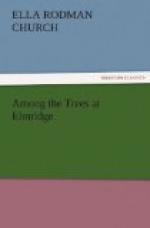“But they’re all interesting,” replied Malcolm, gallantly, “because Miss Harson makes them so.”
“I hope that is not the only reason,” said his governess, laughing, “for trees are always beautiful and interesting and it is a privilege to be able to learn something of their habits and history.—Like most fruit trees, the cherry has many varieties, but it is always a handsome tree, and less spoiled by insects than others of the almond family. The black cherry is the most common species in the United States, and is both wild and cultivated. The garden cherry has broad, ovate, rough and serrate leaves, growing thickly on the branches, and this, with the height of the tree, makes a fine shade. Some old cherry trees have huge trunks, and their thick branches spread to a great distance. The branches of the wild cherry are too straggling to make a beautiful tree, and the leaves are small and narrow. The blossoms of the cultivated cherry are in umbels, while those of the wild cherry are borne in racemes.”
“I remember that, Miss Harson,” said Clara, pleased with her knowledge. “‘Umbel’ means ‘like an umbrella,’ and ‘raceme’ means ’growing along a stem.’”
“Very well indeed!” was the reply; “I am glad you have not forgotten it.—Of our cultivated cherries, we have here at Elmridge, besides the large black ones, which are so very sweet about the first of July, the great ox-hearts, which look like painted wax and ripen in June, and those very acid red ones, often called pie-cherries, which are used for pies and preserves. The cherry is a beautiful fruit, and one that is popular with birds as well as with boys. The great northern cherry of Europe, which was named by Linnaeus the ‘bird-cherry,’ is encouraged in Great Britain and on the Continent for the benefit of the birds, which are regarded as the most important checks to the over-multiplication of insects. The fact not yet properly understood in America—that the birds which are the most mischievous consumers of fruit are the most useful as destroyers of insects—is well known by all farmers in Europe; and while we destroy the birds to save the fruit, and sometimes cut down the fruit-trees to starve the birds, the Europeans more wisely plant them for the food and accommodation of the birds.”
“Isn’t it wicked to kill the poor little birds?” asked Edith.
“Yes, dear; it is cruel to kill them just for sport, as is often done, and very foolish, as we have just seen, to destroy them for the sake of the fruit, which the insects make way with in much greater quantities than the birds do.”
“Miss Harson,” asked Clara, “do people cut down real cherry trees to make the pretty red furniture like that in your room?”
“It is the wood of the wild cherry,” replied her governess, “that is used for this purpose. It is of a light-red or fresh mahogany color, growing darker and richer with age. It is very close-grained, compact, takes a good polish, and when perfectly seasoned is not liable to shrink or warp. It is therefore particularly suitable, and much employed, for tables, chests of drawers, and other cabinet-work, and when polished and varnished is not less beautiful for such articles than are inferior kinds of mahogany.”




